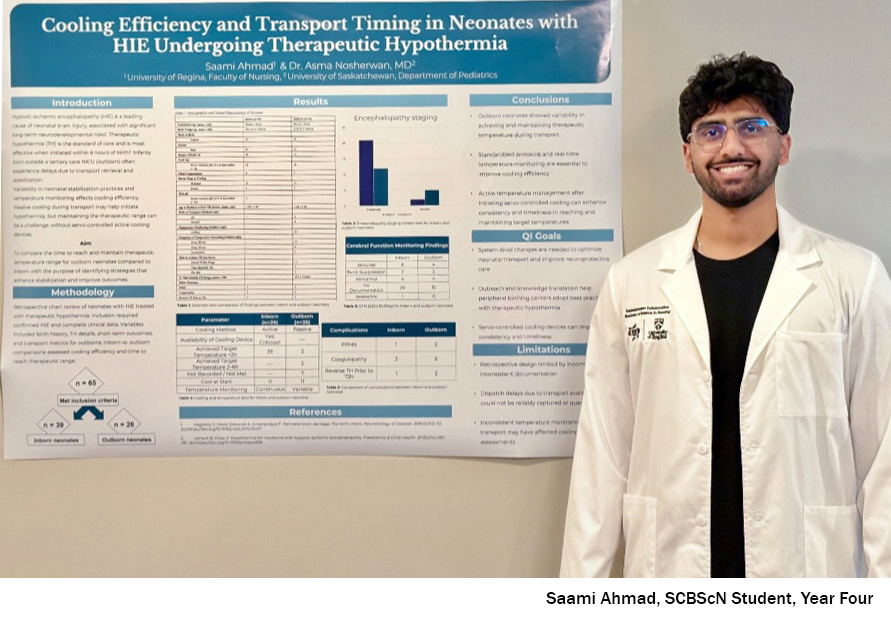Spotlight on Newborn Care
Student Research Shines

For fourth-year nursing student Saami Ahmad, the decision to enter the Saskatchewan Collaborative Bachelor of Science in Nursing (SCBScN) program at the University of Regina and Saskatchewan Polytechnic was rooted in a desire to combine science, compassion, and hands-on practice.
Growing up in Saskatoon, he wasn’t entirely sure what career to pursue after high school, but he knew he wanted to help people. With a father in medicine and a mother in pharmacy, healthcare had always been part of his world. He felt that nursing was the perfect blend of science and service.
"I wanted to do something meaningful, something that let me work with my hands while also making a difference," Ahmad explained. "The SCBScN program had a strong reputation for clinical practice, and that really drew me in."
During his studies, Ahmad was given the chance to participate in a research project with the Department of Pediatrics at the University of Saskatchewan and the Neonatal Intensive Care Unit (NICU) at the Jim Pattison Children’s Hospital (JPCH). The project examines outcomes for newborns with hypoxic-ischemic encephalopathy, a condition caused by reduced blood and oxygen flow to the brain at birth.
Ahmad and his research supervisor, Dr. Asma Nosherwan, a neonatologist and the Director of Neonatal Transport in Saskatoon at JPCH, are comparing the time it takes to reach and maintain therapeutic cooling temperatures for babies born in Saskatoon (“inborn”) versus those transported from other communities (“outborn”). Cooling therapy is critical for protecting vulnerable newborns, but variations in stabilization and transport practices can delay treatment.
"The challenge we’re trying to address is that variability in stabilization practices and temperature monitoring affects cooling efficiency," Ahmad explained. "At the very least, our work will inform changes for the NICU that should improve outcomes for this vulnerable patient group."
 The project has offered a new perspective to Ahmad on the health disparities that can arise across Saskatchewan’s diverse geography.
The project has offered a new perspective to Ahmad on the health disparities that can arise across Saskatchewan’s diverse geography.
"What stands out most to me is how geography can profoundly impact patient outcomes," he said. "I was surprised to see just how much transport time and access to specialized care can influence the experiences of patients and families."
Although his coursework had explored rural-urban differences in access to care, this was the first time Ahmad saw the effects firsthand. The project reinforced his belief in the importance of evidence-informed practice and the need for research that translates directly into better patient outcomes.
The implications of the study extend beyond the NICU itself and may help refine neonatal transport protocols, leading to more consistent care across the province.
"Ultimately, this research helps ensure that every infant, whether born in a tertiary centre or a rural hospital, has an equal opportunity for the best possible start to life."
The project was showcased at the Canadian Pediatric and Neonatal Transport Conference in Ottawa from October 15-16. Although Ahmad was unable to attend in person, he takes pride in knowing his work was presented to professionals from across Canada.
"It means a lot for our work to be seen at that level," he said. "The SCBScN program really prepared me for this – from research methods, to poster design, to interprofessional communication. I’ve been able to apply everything I’ve learned."
As he approaches graduation, Ahmad is already thinking about how this experience will shape his future. He hopes to eventually pursue a master’s degree or further graduate studies, building on the lessons he has learned in research and clinical practice.
"This project has shown me why evidence-informed practice is so important in nursing and healthcare," he reflected. "It’s given me a practical example of how research can directly improve patient care, and I want to carry that forward into my career."
View the conference poster titled Cooling Efficiency and Transport of Timing in Neonates with HIE Undergoing Therapeutic Hypothermia [245KB, PDF].